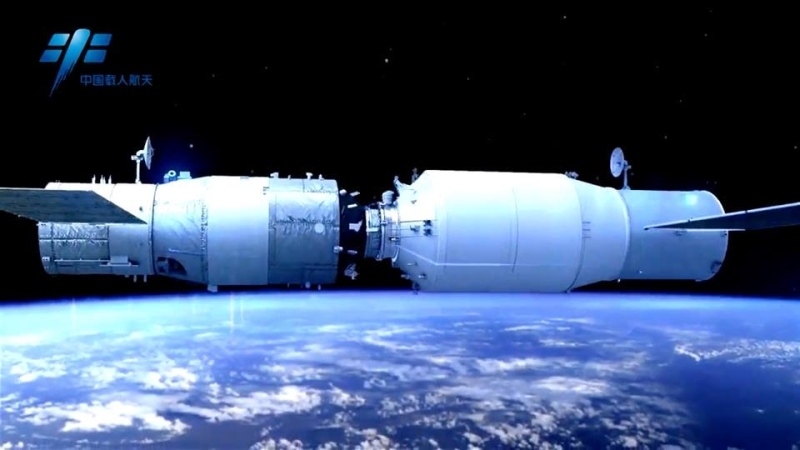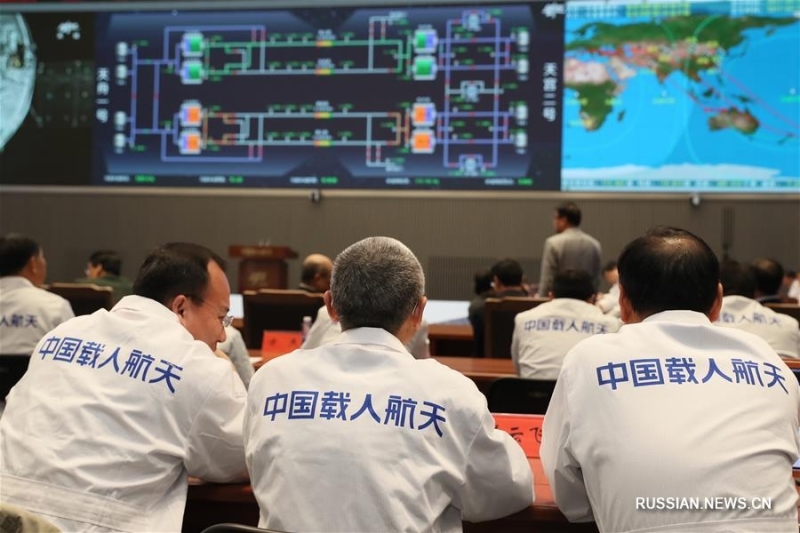China is ready for long flights at orbital stations
At the end of last week, official representatives of the Chinese National Space Administration announced the success of the experiment to refuel the Tyangun-2 orbital station from the Tianzhou-1 cargo ship. Thus, China successfully checked all the technologies for long manned flights at orbital stations.

Tianzhou-1 for moments before docking, frame from CCTV4 video
The Tianzhou-1 cargo ship was launched on April 20 at 11:41 UTC (night had already arrived at the Wenchang cosmodrome, local time). This was the second launch of the Great March-7 launch vehicle, first launched in 2016. A cargo ship weighing 12,910 kg was the heaviest payload ever launched by China into orbit.
')
Two days later, on April 22, the cargo ship automatically approached the Tyangun-2 station and docked at 4:16 UTC. At the beginning of the video in accelerated mode, the truck approaches the station and the exit to the docking axis is shown, then the video goes on a real time scale and shows the final rendezvous and docking. The automatic approach began at a distance of 52 km and took place in several stages - the cargo ship approached and stopped at a distance of 5000, 400, 120 and 30 meters. It is claimed that the automatic docking system operates in the radio and optical bands and uses radar and lasers.
It is curious that the cargo compartment of "Tianzhou-1" was loaded with containers, obviously, with cargo mock-ups. According to available information, no one is going to unload them - there are no plans for new manned launches at the Tiangun-2.

Inside "Tianzhou-1", a frame from the broadcast docking
Structurally, the cargo ship and the station are similar, which suggests that the "Tianzhou" was made on the basis of the orbital stations "Tyangun". The Tianzhou length is 10.4 meters, the cargo compartment diameter is 3.35 meters, the maximum weight is 13,500 kg (limited by the carrying capacity of the Great Trip-7 carrier), and the cargo compartment volume is 15 cubic meters. They also write that for the cargo ship they came up with three equipment options - with one airtight compartment, with one non-hermetic compartment and mixed with hermetic and non-hermetic compartments.

Tianzhou-1 and Tiangong-2, drawing by the China Space Agency
For refueling, four connectors were used - one for the fuel and the oxidizer and two for the gas pressurized tanks.

Connectors around the docking device, photo chinaspaceflight.com

Presumably the diagram of the pneumatic-hydraulic system of the truck and the station, Xinhua photo
According to the plans announced, Tianzhou-1 will undock from the station and try to dock again and refuel it a second time in June. Then he will undock again and check the technology of rapid approach to the station, similar to the Russian six-hour scheme used since 2012. And after that, refuel the station for the third time.
The successful tests of the Tianzhou-1 cargo ship completed the second of three stages of the Chinese manned space program. The first stage was successfully completed in 2003, when the first Chinese astronaut Yang Liwei went into orbit. And the third stage is the construction of a modular station, similar to Mira or the ISS, and long crew watches on it. A cargo ship is the key to long flights at orbital stations, because it allows you to bring supplies, consumables and experiments for the crew and fuel to maintain the station’s orbit. As expected, the base unit of the Tianhe modular Chinese station will go into orbit in 2019, and the launch of the second cargo ship Tianzhou is scheduled for the same year.

Tianzhou-1 for moments before docking, frame from CCTV4 video
The Tianzhou-1 cargo ship was launched on April 20 at 11:41 UTC (night had already arrived at the Wenchang cosmodrome, local time). This was the second launch of the Great March-7 launch vehicle, first launched in 2016. A cargo ship weighing 12,910 kg was the heaviest payload ever launched by China into orbit.
')
Two days later, on April 22, the cargo ship automatically approached the Tyangun-2 station and docked at 4:16 UTC. At the beginning of the video in accelerated mode, the truck approaches the station and the exit to the docking axis is shown, then the video goes on a real time scale and shows the final rendezvous and docking. The automatic approach began at a distance of 52 km and took place in several stages - the cargo ship approached and stopped at a distance of 5000, 400, 120 and 30 meters. It is claimed that the automatic docking system operates in the radio and optical bands and uses radar and lasers.
It is curious that the cargo compartment of "Tianzhou-1" was loaded with containers, obviously, with cargo mock-ups. According to available information, no one is going to unload them - there are no plans for new manned launches at the Tiangun-2.

Inside "Tianzhou-1", a frame from the broadcast docking
Structurally, the cargo ship and the station are similar, which suggests that the "Tianzhou" was made on the basis of the orbital stations "Tyangun". The Tianzhou length is 10.4 meters, the cargo compartment diameter is 3.35 meters, the maximum weight is 13,500 kg (limited by the carrying capacity of the Great Trip-7 carrier), and the cargo compartment volume is 15 cubic meters. They also write that for the cargo ship they came up with three equipment options - with one airtight compartment, with one non-hermetic compartment and mixed with hermetic and non-hermetic compartments.

Tianzhou-1 and Tiangong-2, drawing by the China Space Agency
For refueling, four connectors were used - one for the fuel and the oxidizer and two for the gas pressurized tanks.

Connectors around the docking device, photo chinaspaceflight.com

Presumably the diagram of the pneumatic-hydraulic system of the truck and the station, Xinhua photo
According to the plans announced, Tianzhou-1 will undock from the station and try to dock again and refuel it a second time in June. Then he will undock again and check the technology of rapid approach to the station, similar to the Russian six-hour scheme used since 2012. And after that, refuel the station for the third time.
The successful tests of the Tianzhou-1 cargo ship completed the second of three stages of the Chinese manned space program. The first stage was successfully completed in 2003, when the first Chinese astronaut Yang Liwei went into orbit. And the third stage is the construction of a modular station, similar to Mira or the ISS, and long crew watches on it. A cargo ship is the key to long flights at orbital stations, because it allows you to bring supplies, consumables and experiments for the crew and fuel to maintain the station’s orbit. As expected, the base unit of the Tianhe modular Chinese station will go into orbit in 2019, and the launch of the second cargo ship Tianzhou is scheduled for the same year.
Source: https://habr.com/ru/post/403545/
All Articles